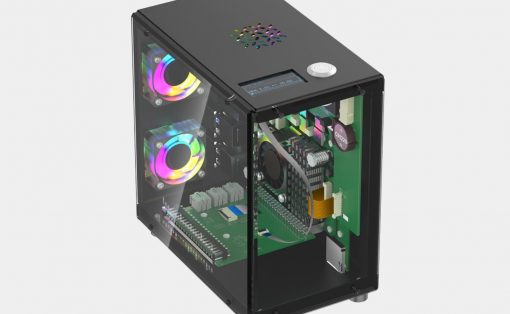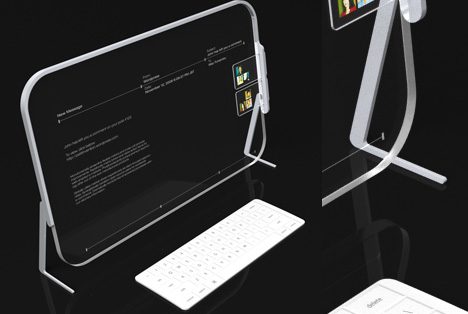As we celebrate the 40th anniversary of the Apple Macintosh, we reflect on how this technology has transformed our lives. The Macintosh changed how we interact with computers and redefined our relationship with technology. In 1984, Apple introduced the Macintosh, a computer that put the future at our fingertips. It embraced the philosophy of human-centric design long before it became a popular term in design circles.
Designer: Apple Computer, Inc.
![]()
Its graphical user interface (GUI) was a significant departure from the cumbersome command-line interfaces of the time. Using icons, windows, and a friendly desktop metaphor made technology accessible and approachable. This leap was not solely about technology but also about how humans interact with it.
On January 24, 1984, Steve Jobs famously unveiled the first Macintosh by dramatically pulling it out of a bag. The personal computer boasted a 9-inch black and white display powered by an 8MHz Motorola processor and 128KB of RAM. In classic Steve Jobs style, he then produced a 3.5-inch floppy drive and inserted it into the computer, much to the delight of Apple shareholders. Jobs had famously said, “We want to put an incredibly great computer in a book that you can carry around with you and learn how to use in 20 minutes.” At its launch, the original Macintosh cost $2,495.
Design Aesthetics: More Than a Machine
The all-in-one design of the Macintosh broke the mold. Its compact, boxy frame, complete with a built-in 9-inch screen, was an object of desire – sleek, stylish, and something you wouldn’t mind having on your desk. Looking back, it was more than a machine; where multiple layers of innovation and thoughtful design choices distinguish it from anything else of its time, it was a piece of art that complemented the user’s space.
The Macintosh computer differed from the early personal computers as it didn’t have a bulky, segmented design with separate units for the monitor, CPU, and keyboard. Instead, it had a compact, all-in-one design. This unique design of integrating the monitor and computer into a single unit was not only space-efficient but also symbolically significant. It represented a unified, holistic approach to computing, aligning with the philosophy that technology should seamlessly integrate into people’s lives without complicating them.
The friendly beige plastic casing, rounded edges, and compact size make it appear warm and approachable. The designers wanted to communicate that technology can be pleasant and welcoming rather than intimidating and alienating. Steve Jobs, known for his attention to detail regarding aesthetics, believed that good design was integral to the user experience. He famously said, “Design is not just what it looks and feels like. Design is how it works.” He believed good design, not just a superficial veneer, was essential to make things look good.
Did you know that the Macintosh had some fantastic design elements? One of the most unique features was the handle on the computer’s top. Not only was it functional, but it also represented portability and personal ownership. It made you feel like the Macintosh was your personal computer, one you could take charge of and create your own. This feature reflected a shift in how we see computers, from impersonal corporate machines to personal tools for creativity and expression.
The Macintosh’s 9-inch screen may seem tiny now, but it was a big deal in the day. It’s what made the Mac look so cool and funky. The cool thing about it was that it showed graphics and text in a way that had never been seen before. It was like a window into the heart of the Macintosh, showing everyone what made it unique and innovative.
Bridging Human and Machine: The Mighty Mouse – A Closer Look
When Apple Macintosh introduced the mouse, it wasn’t just another peripheral device. It changed the way we interact with machines. This tiny device played a massive role in connecting the digital world with its users. It transformed the personal computer from a specialized tool to an accessible and creative medium.
![]()
The mouse, tailored for the human hand, turned physical gestures into digital actions. Its design was simple yet effective – a small, palm-sized device with a single button, embodying the principle of simplicity and ease of use. This approachability was crucial. It invited users who might have been intimidated by the complexity of computers to explore this new world. Steve Jobs, ever the proponent of intuitive design, understood this connection, emphasizing, “We made the buttons on the screen look so good you’ll want to lick them.” The mouse was an extension of this philosophy, making the digital environment tangible and inviting.
Before the Macintosh, interacting with computers mainly involved typing commands – an efficient method for experts but alienating for novices. The mouse changed that, making computing a more intuitive, point-and-click experience. This change was akin to learning a new language where actions and commands became visual and direct. The mouse demystified the computer, aligning its use more closely with natural human behavior and less with the need to learn complex command languages.
The mouse was integral to the success and functionality of the Macintosh’s GUI. It allowed users to navigate the interface easily, interact with icons, open windows, and use menus. This ease of navigation made the computer’s advanced capabilities accessible to a broader audience, fostering a more inclusive digital culture. The mouse and GUI combination was a powerful duo that set the standard for future user interfaces, influencing the design of operating systems and software for decades. Applications became more visually oriented, focusing on ease of use and accessibility. Programs like MacPaint and MacWrite showcased what was possible with this new form of interaction, allowing users to create graphics and documents in previously unimaginable ways on a personal computer.
Over the years, the mouse has evolved, gaining more buttons, adopting new technologies like laser tracking and wireless connectivity, and even transforming into touchpads and touchscreens in modern devices. However, the core principle remains: technology should adapt to human needs, not vice versa.
In celebrating the 40th anniversary of the Macintosh, the significance of the mouse in bridging humans and machines cannot be overstated. It was a bold step towards making technology more personal, intuitive, and human. The Macintosh’s mouse was a harbinger of a future where technology becomes an extension of ourselves, seamlessly integrated into our daily lives, facilitating creativity, productivity, and exploration in the digital realm.
Echoing Steve Jobs’s vision, he said, “It’s in Apple’s DNA that technology alone is not enough — it’s technology married with liberal arts, married with the humanities, that yields us the result that makes our heart sing.”
The Macintosh made our hearts sing then, and forty years on, its legacy continues to inspire.






